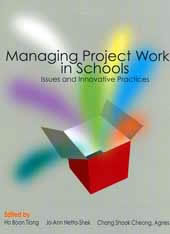Managing Project Work in Schools: Issues and Innovative Practices
Edited by Ho Boon Tiong, Jo-Ann Netto-Shek and Chang Shook Cheong Agnes. Pearson Prentice Hall, ISBN: 981-244-733-4, 264 pp.

As its title suggests, this book examines the issues and processes involved in managing Project Work (PW) in schools. This includes different insights and strategies on how to handle PW in an innovative and effective manner, which would allow students to benefit from it.
The first part of the book provides teachers with the knowledge of how to create a foundation in initiating and facilitating PW. The book’s second chapter entitled, “Coaching and Facilitating Project Work”, teaches readers how to do effective cognitive coaching of PW. It also provides simple tools for metacognitive coaching, which focuses on helping learners monitor their own cognitive process. These tools not only teach readers the different forms of coaching, but also how to go about doing it.
Other chapters in the first part of the book also provide readers with different tools for organising, assessing and monitoring PW. Readers will find that all these tools are simple but effective and practical to use.
The second part of the book discusses research studies on PW. This includes reflections from students and teachers as well. According to the book, research shows that students across levels are able to benefit from PW although there are areas where they still face problems in carrying out PW. Teachers who are now practising PW may use these analyses as a framework in refining their own PW to better suit the students’ abilities.
Part Three of the book explores the task of conducting of PW with students of different learning abilities. It looks into how PW can be conducted with both students in the lower ability stream and those in the Gifted Education programme. Readers are presented with series strategies, which provide a framework for conducting PW effectively to suit students’ learning abilities.
This is complemented by the fourth part of the book, which touches on the different approaches in executing PW. Teachers will be interested to find out that PW can be done through problem-based learning (PBL), experiments, stories and even drama. Writers even include some instructional steps on how to use these different approaches. Thus, readers get a better insight into how they work in relation to PW.
The last part of the book shares other resources that teachers can turn to for help when conducting PW. These resources are easily accessible and available to readers.
This book is a practical and useful guide for those who are interested in PW and need an essential understanding of it. I would definitely recommend it for new teachers involved in PW in schools.






